
| **8878 Catocala amica;
Girlfriend; wingspan: 35-40mm
The black postmedian band is absent from the dorsal (upper)
surface of the hindwing, but it is present on the ventral surface.
Moths come in to lights and to bait.
Catocala amica lineella is now (2010) elevated to full species status as Catocala lineella.
Maurice Bottos image.
|
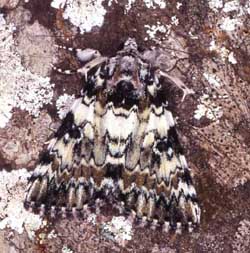
| ** 8877 connubialis,
Connubial Underwing, (wingspan: 35-50mm).
The forewing is highly variable and there are several different
forms: "sancta" Hulst is the typical form and has forewings with
white ground colour and sharply contrasting black lines and markings.
There is also brown shading between post medial and subterminal
lines; "cordelia" H. Edwards is coloured as above but markings are
faint; "pulverulenta" Brower has grey-green forewings with faint
markings, sometimes none;
"broweri" Muller is the melanic form with forewings that are dark
green, almost black.
The hindwing has a separate anal spot and the outer band ends with a
straight cut.
Leroy Simon image.
|

| ** 8775
antinympha;
Sweetfern Underwing, wingspan 45-55mm.
Very dark grey, almost black, forewing ground colour
distinguishes antinympha. Some brown shading in
subreniform spot and also just outside postmedial line.
The hindwing is amber to pale orange.
There is also the form multoconspicua Reiff, 1919 with a pale,
almost white subreniform spot.
|
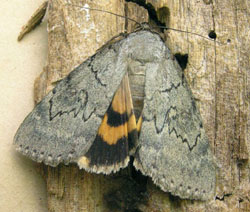 |
** 8779 serena
Serene Underwing.
The head and collar and abdomen are brown while the thorax is grey.
The am and pm lines are thin but very dark and distinct on an
otherwise drab, almost uniformly olive-grey forewing.
The black marginal band of the lower wings is indented at the center,
and the relatively narrow, deep yellow median band parallels this
indentation. Basal hairs are brown.
Catocala serena courtesy of
Carroll Rudy, July 28, Calumet County, Wisconsin.
|

| ** 8857 Catocala ultronia;
Ultronia Underwing, wingspan: 50-63mm.
Fws typically gray-brown, with a distinct and very
dark inner margin and characteristic light brown patch, underscored
by very dark arc, near wingtip.
Underwings can be yellow to orange to salmon.
|

| ** 8857 Catocala ultronia form lucinda;
Ultronia Underwing, wingspan: 50-63mm.
In form lucinda most of the forewing
is bright grey. On all forms there is
extensive orange-salmon colouration on hw ventral surface,
and there is a dark discal lunule.
|
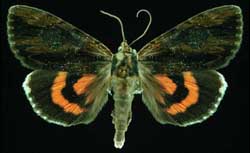
| Catocala ultronia,
form nigrescens, the Ultronia Underwing, wingspan: 50-63mm.
In the melanic form nigrescens, the dorsal forewing is very dark.
Even darker subapical arc, basal dash and dash near anal angle are still visible.
Dark basal hairs on hindwing.
Harold J. Vermes slide, used with permission from his son.
|

|
In form celia there is a wide, light grey band separating a dark region along inner margin and
a dark patch near the apex.
The ventral surface of forewings of all forms has a generous suffusion
of orange-salmon scales in the lower half of the median area.
|
 |
** 8779 serena
Serene Underwing. 55-60mm.
Head, collar and abdomen are brown while thorax is grey.
Am and pm lines are thin but very dark and distinct on an
otherwise drab, almost uniformly olive-grey forewing.
Black marginal band of the lower wings is indented at the center,
and relatively narrow, deep yellow median band parallels this
indentation. Basal hairs are brown.
Catocala serena courtesy of
Carroll Rudy.
|
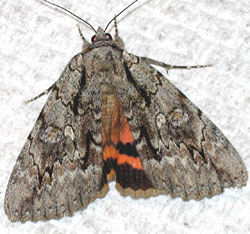
| #8778
Catocala habilis;
wingspan: 55-65mm
Large "M" on thorax,
"pork chop" shaped, light coloured subreniform spot very
dark in constriction at juncture with pml. Pml narrow, dark, distinct, outwardly lined with
narrow suffusion of white scales, followed by broader band of brown
scales, then broader suffusion of white scales up to
very regular dentation of sbtml line.
Significant "bleeding" of yellow-orange-salmon scales into
hw fringes.
Large reniform spot has brown center, faintly edged in black, then
white, then black again.
|

| ** 8770
Catocala innubens;
Betrothed; 55-72mm.
Forewing is mottled with white, grey and brown, and
subrenifrom spot tends to be lighter in colour, although it is
sometimes obscured by an indistinct blackish bar which runs from
middle of basal/thorax connection to just below much lighter
apex at outer margin.
Jim Vargo image. |
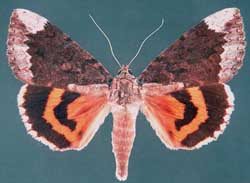
| ** 8770
Catocala innubens form scintillans;
Betrothed; 55-72mm.
In form scintillans most of the basal area (all but lower third) and all of the median area of the forewing is dark reddish brown.
The area outside the pm line is grey.
Vernon A Brou image. |

| #8795 Catocala palaeogama
; wingspan: 60-70mm.
Subreniform spot closed, does not approach pm line,
is smaller than in C. habilis.
All forms have characteristic orange, heavily barred fringe to
apex, and irregular bands on hws. Hw basal median
area heavily suffused with dark brown to black scales.
Dark bar in outer half of median area,
paralleling i. m. halfway between
i. m. and light, closed subreniform spot.
Joe Garris photo.
|

| #8795 Catocala palaeogama
form phalanga; wingspan: 60-70mm.
In this form, fw basal area and subterminal
area are very dark against a much lighter background.
Dark bar in the outer half of the
median area, paralleling the inner margin halfway between
the inner margin and the light, closed subreniform spot is especially
evident. Joe Garris image.
|
Solid Black Underwings: Smallest to Largest, Similar Species Paired
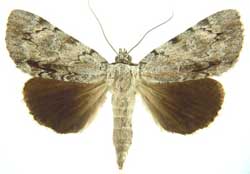
|
miranda,
Miranda Underwing; 37-45mm;
Fw: plain pale grey with very light and fine black lines, darker and wider near costa. Hw
black with white fringe at the apex, turning to grey along the outer margin.
Miranda is smaller than look-alike orba and miranda also has a dark bar just above the inner margin in
the median area, projecting toward the anal angle.
|

| ** 8781
judith,
Judith's Underwing, (wingspan: 45-55mm), yes,
small "black" underwing. FW uniform
light grey with thin, only slightly darkened am, median
and pml lines. No darkened dashes (slight anal dash)
or transverse lines. Reniform area slightly darkened while
area just before subterminal line is bit lighter. Note absence of
hw white fringe. Joe Garris photo. unconfirmed
|

| ** 8782 Catocala flebilis, yes;
Mournful, wingspan: 54-65mm.
Diffuse black band runs from basal area to
outer margin just below the apex, interrupted by a pale grey
subreniform spot. The reniform spot is filled with brown and there is
additional brown outside the postmedial line. There is no anal dash
as there is in angusi. The hindwings have white fringe. J. K. Adams
image.
|
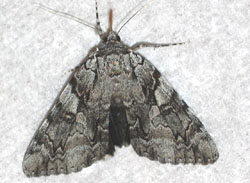
|
Catocala dejecta;
Dejected; wingspan 56-73mm. Pale grey patch
from reniform and subreniform juncture to costal margin is
diagnostic. Note open, light "pork chop" shape of subreniform spot.
Two "teeth" in pml above subreniform spot are relatively
short and blunt. Upper portion of aml thick and black;
lower half has light rounded lobes outlined in black.
Hw fringe is white with black wing veins extending
like "teeth".
|
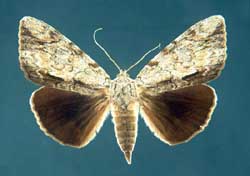
| ** 8791
Catocala insolabilis;
Inconsolable, wingspan: 65-75mm;
Fw light grey with blackish shading along inner
margin. Antemedial and postmedial lines are thin.
Hw fringe very narrow and grey, becoming whiter toward
apex.
Ventral surface clearly distinguishes insolabis, being almost
completely black except for some white in basal area.
Vernon A. Brou image.
|
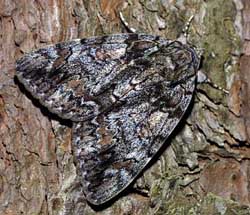
| ** 8794
Catocala lacrymosa;
Tearful Underwing, 60-82mm.
The forewing is highly variable with a mixture of black, brown
(wing tips and outside postmedial line) and dark grey scaling.
There are usually whitish crescents, along the inner margin at the
base of the antemedial and postmedial lines.
The hindwings are black with white checkered fringe, turning black
near the anal angle. There are several different forms.
|
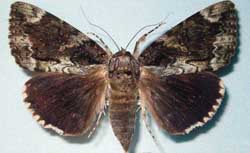
| ** 8794
Catocala lacrymosa;
Tearful Underwing, 60-82mm.
Form paulina: lighter grey post median area & area along and parallel to inner margin, in sharp contrast to
darker basal median areas.
|

| ** 8794
Catocala lacrymosa;
Tearful Underwing, 60-82mm.
In form evelina there is a wide black band along the forewing inner margin.
|
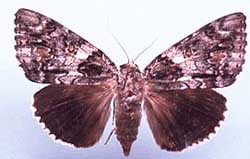
| ** 8794
Catocala lacrymosa;
Tearful Underwing, 60-82mm;; GSMNP/TP/WAM/KC.
In form albomarginata there is an abundance of white scaling on the forewing.
|
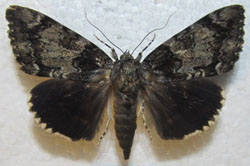
| ** 8794
Catocala lacrymosa;
Tearful Underwing, 60-82mm;; TP.
Form "zelica", has black basal patch and strong black subterminal line.
|
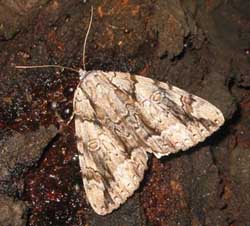
| ** 8792
Catocala vidua;
Widow; 70-80mm.
Fw ground colour light grey.
Distinguishing dark arc runs through top of reniform spot
to just below apex. Heavy, dark anal and basal
dashes, connecting to dark median bar, running parallel to i. m.
Am line thick, black in its upper half.
Reniform spot with two almost
concentric irregular ovals.
Subreniform spot light, open, constricted as it
meets pm line.
Hw black with broad, white fringe, lightly
interrupted.
Marie Winn image. |

| ** 8802
Catocala cerogama;
Yellow-Banded; 70-80mm.
Several different forms. Pm line distinct, dark
and has elongate pair of projections. Pm and am lines meet inner
margin in relative proximity. Closed subreniform spot
lighter than surrounding areas, shaped a bit like an
arrowhead with point toward body. Hws are
distinctive. Jean-Benoît Duval image. |

|
Form ruperti: Forewings are almost uniform grey-brown with white scales outlining subterminal line.
The hindwings are
distinctive. Tim Dyson image. |

|
Form bunkeri: Forewings are dark in median and basal areas.
Hw golden band is reduced in thickness. Basal hairs are brown instead of yellow.
The hindwings are
distinctive. Tim Dyson image. |
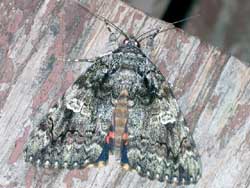
| ** 8801
Catocala ilia; Ilia;
wingspan: 65-82mm.
Several different forms,
most have characteristic white area in and around
reniform spot. Diffuse dark arc running from this
spot to just below apex. Subreniform spot squarish, concave inner and outer edges
and elongated constriction connecting it to pml.
White dots near fw om in character
with the overall "contrasting" appearance.
|

| ** 8801
Catocala ilia; Ilia;
form conspicua
In this form the entire reniform spot is heavily suffused with white scaling on
an otherwise darker ground colour. Hence the form name "conspicua".
Tim Dyson image.
|

| ** 8801
Catocala ilia; Ilia;
form satanas
In this melanic form the entire forewing, including the reniform spot is very dark. Hence the form name "satanas".
The dark basal streak is still evident on this form.
Tim Dyson image.
|
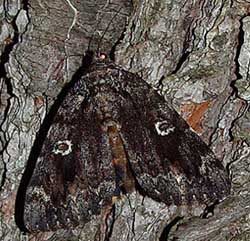
| ** 8801
Catocala ilia; Ilia;
form normani
In this semi-melanic form the entire forewing, excluding the reniform spot, is relatively dark.
The brownish, kidney-shaped center of the reniform spot is outlined in white.
The basal streak and subapical arc are still visible.
Tim Dyson image.
|

| ** 8771 Catocala piatrix ;
Penitent, wingspan: 68-84mm.
Fw: light-colored band/bar extending from light coloured, triangular
subreniform spot along am line to costa. Brown, kidney-shaped reniform spot surrounded in pale grey, outlined in black,
usually with distinct black along wing veins in a dark area outside the reniform spot.
Hw: fringe lightly barred; lighter in color
than deeper orange on rest of wing.
|

| ** 8806 Catocala parta;
Mother Underwing, wingspan: 70-85mm.
The black dashes in the basal, subapical and anal areas help to
identify this species. The hindwings may be yellow to
yellowish-orange but more often are salmon-red. Note the
face-head-like markings on the thorax.
In the hindwing, the first (nearest the apex) black protrusion into
the white fringe is "noticeably" larger than the others.
|
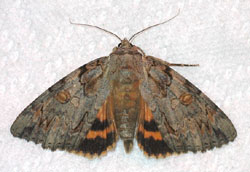
| ** 8798 Catocala neogama;
wingspan 70-85mm.
Brown head, thorax, larger size as compared to
C. palaeogama. Neogama tend to be slightly smaller
than subnata, have darker grey brown fws with more
pronounced markings. Examination of hind tibia needed
for id. Neogama's: flattened,
unevenly, sparsely spined; subnata's: cylindrical,
spines dense, uniform in distribution.
Joe Garris photo.
|
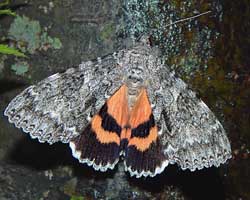
| ** 8805 unijuga;
Once-married; wingspan: 70-90mm: Catocala unijuga has a
fairly wide black inner band (almost reaching inner margin) in
hindwing and very distinctive patterning in forewing. Meskei tend to
have narrower band and dustier (less distinct) looking forewing.
Semirelicta tend to have inner bands that terminate well before
inner margins.
Also note the very white fringe on both the forewings and hindwings.
Carroll Rudy image.
|
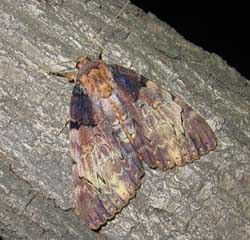
| Catocala nebulosa;
Moths have prominent dark brown upper-half-basal patch that extends
to and ends at antemedial line. Apical area also tends to be
brown, much darker than median area but not as dark as basal patch.
The anal angle also has the darker brown scaling.
The pm line is distinct near costa and inner margin, but becomes
weak between the two. It meets inner margin in relative close
proximity to am line.
Closed subreniform spot is large and connects to the
pm line via a thin line.
|

| ** 8833 concumbens
Sleepy Underwing or
Pink Underwing, 60-75mm).
This brown thoracic collar is quite evident in this image as is the
interruption in the pm line by the open subreniform spot.
The white hindwing fringe is only lightly checked
on the wing veins. The vibrant pink bans are
distinct in colour and also in their relatively smooth contour.
|
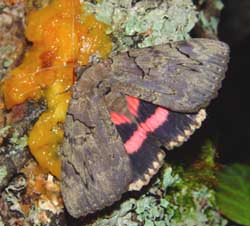
| ** 8832 Catocala cara;
Darling; 70-85mm; WO?.
Note deep maroon almost purple cast to fws, mixed with
very pale green. Lower half of am & pm lines is barely
visible. There are no distinctive bars or dashes. The two upper
"teeth" on the pm line are thin and long.
The hindwing bands are pink. There is heavy black checking on the
off-white hindwing fringe. The relatively thick black median band of the
hindwing almost reaches the inner margin which is usually heavily
adorned with dark hairs.
Tim Dyson image.
|
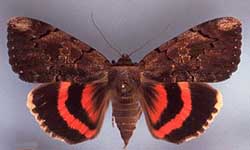
| ** Catocala carissima;
wingspan 70-85mm. Distinct light grey brown area at fw apex, preceded just inside pm line by slightly darker patch.
Am and pm lines sharp and dark.
Hw inner black band wide, complete, merges with extensive grey-black scaling along im. Hw fringe cream coloured.
|

|
** 8834 amatrix
Sweetheart Underwing; (wingspan 75-95mm).
Very skittish, frequently hides in caves, under
bridges, under tree bark, etc. by day, resting with head down.
Hw patterning and colouration similar to that of
C. concumbens, but large size (wingspan 75-95mm)
and dark bar running from basal area to just below apex
distinguishes C. amatrix. See large
Catocala amatrix courtesy of
Joan F. Rickert.
|

|
** 8834 amatrix form selecta
Sweetheart Underwing; (wingspan 75-95mm)
Very skittish and frequently hides in caves, under
bridges, under tree bark, etc. by day, resting with head down.
Several forms, including selecta (to the left)
which lacks dark bar on forewing. Hesseli: melanic form;
pallida: very pale form.
|
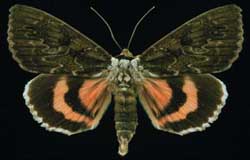
|
** 8834 amatrix form hesseli
Sweetheart Underwing; (wingspan 75-95mm)
Very skittish and frequently hides in caves, under
bridges, under tree bark, etc. by day, resting with head down.
The melanic form hesseli is very dark and displays dark basal hairs in the hindwing.
|
Goto Main Index
Use your browser "Back" button to return to the previous page.
Visit "Systematics of moths in the genus Catocala (Lepidoptera, Erebidae) IV.
Nomenclatorial stabilization of the Nearctic fauna, with a revised synonymic check list";
ZooKeys 39: 37–83 (2010) by Lawrence F. Gall, David C. Hawks
|